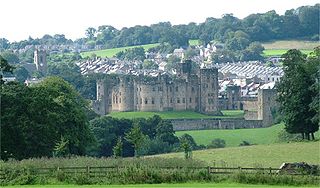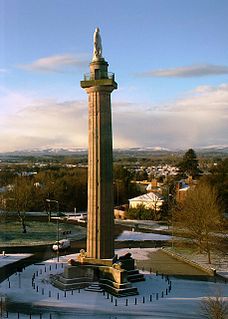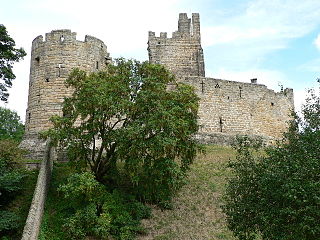
Alnwick is a market town in Northumberland, England, of which it is the traditional county town. The population at the 2011 Census was 8,116.

Alnwick Castle is a castle and country house in Alnwick in the English county of Northumberland. It is the seat of The 12th Duke of Northumberland, built following the Norman conquest and renovated and remodelled a number of times. It is a Grade I listed building and as of 2012 received over 800,000 visitors per year when combined with adjacent attraction The Alnwick Garden.

Hulne Priory, Hulne Friary or Hulne Abbey was a friary founded in 1240 by the Carmelites or 'Whitefriars'. It is said that the Northumberland site, quite close to Alnwick, was chosen for some slight resemblance to Mount Carmel where the order originated. Substantial ruins survive, watched over by the stone figures of friars carved in the 18th century. It is a sign of the unrest felt in this area so near to the border with Scotland that the priory had a surrounding wall and in the 15th century a pele tower was erected. Changes were made at the Dissolution of the Monasteries when the Percy family took control.

Duke of Northumberland is a noble title that has been created three times in English and British history, twice in the Peerage of England and once in the Peerage of Great Britain. The current holder of this title is Ralph Percy, 12th Duke of Northumberland.

The title of Earl of Northumberland has been created several times in the Peerage of England and of Great Britain, succeeding the title Earl of Northumbria. Its most famous holders are the House of Percy, who were the most powerful noble family in Northern England for much of the Middle Ages. The heirs of the Percys, via a female line, were ultimately made Duke of Northumberland in 1766, and continue to hold the earldom as a subsidiary title.
The year 1816 in architecture involved some significant architectural events and new buildings.

Petworth House in the parish of Petworth, West Sussex, England, is a late 17th-century Grade I listed country house, rebuilt in 1688 by Charles Seymour, 6th Duke of Somerset, and altered in the 1870s to the design of the architect Anthony Salvin. It contains intricate wood-carvings by Grinling Gibbons (d.1721). It is the manor house of the manor of Petworth. For centuries it was the southern home for the Percy family, Earls of Northumberland.

The House of Percy is an English noble family. They were one of the most powerful noble families in Northern England for much of the Middle Ages, known for their long rivalry with another powerful northern English family, the House of Neville.

Northumberland House was a large Jacobean townhouse in London, so-called because it was, for most of its history, the London residence of the Percy family, who were the Earls and later Dukes of Northumberland and one of England's richest and most prominent aristocratic dynasties for many centuries. It stood at the far western end of the Strand from around 1605 until it was demolished in 1874. In its later years it overlooked Trafalgar Square.

Lieutenant General Hugh Percy, 2nd Duke of Northumberland was an officer in the British army and later a British peer. He participated in the Battles of Lexington and Concord and the Battle of Long Island during the American War of Independence, but resigned his command in 1777 due to disagreements with his superior, General William Howe.

Alnham is a hamlet and civil parish in Northumberland, England. It is about 14 miles (23 km) west of Alnwick, about 6 miles (9.7 km) from Scotland and is located on the south of a small tributary of the River Aln. The village stands on uneven ground, sloping from south to north, at the foot of the southern outliers of the Cheviot Hills. The River Aln flows eastward through the village from its source in the Cheviot Hills down to the coast. The layout of the village appears to have been dictated by the river. The estimated population taken at the 2011 Census was around 245.

Brizlee Tower is a Grade 1 listed folly set atop a hill in Hulne Park, the walled home park of the Duke of Northumberland in Alnwick, Northumberland. The tower was erected in 1781 for Hugh Percy, 1st Duke of Northumberland, and commands extensive views over North Northumberland and the Borders.

Lord Hill's Column is a monument located outside of Shropshire Council's headquarters, Shirehall, in the town of Shrewsbury, Shropshire. It is a column of the Doric order and measures 133 ft 6 in (40.7 m) in height making it the tallest Doric column in England. It commemorates General Rowland Hill, 1st Viscount Hill, with a 17 ft (5.2 m) tall statue standing on the top of the column. The column is shorter than the 44.5m 'Monument to British Liberty' at Gibside, but the combined height of the column and statue is higher in total. The column was built between 1814 and 1816; its diameter is 2 ft (0.6 m) wider than Nelson's Column, and, not including the pedestal, is 15 ft (4.6 m) higher.

Prudhoe Castle is a ruined medieval English castle situated on the south bank of the River Tyne at Prudhoe, Northumberland, England. It is a Scheduled Ancient Monument and a Grade I listed building.

The White Swan Hotel is a hotel in the middle of the historic market town of Alnwick, Northumberland, England. The hotel is a 300-year-old coaching inn and is a Grade II listed building. Its most distinctive feature is the Olympic Suite, a large room furnished with interior decorations from the RMS Olympic.

Warkworth Castle is a ruined medieval castle in Warkworth in the English county of Northumberland. The village and castle occupy a loop of the River Coquet, less than a mile from England's north-east coast. When the castle was founded is uncertain: traditionally its construction has been ascribed to Prince Henry of Scotland, Earl of Northumbria, in the mid-12th century, but it may have been built by King Henry II of England when he took control of England's northern counties. Warkworth Castle was first documented in a charter of 1157–1164 when Henry II granted it to Roger fitz Richard. The timber castle was considered "feeble", and was left undefended when the Scots invaded in 1173.

The Camphill Column in Alnwick, Northumberland, is a stone column erected in 1814, celebrating a number of British victories over the French and others, and the restoration of peace to Europe. It carries inscriptions to Pitt, Wellington, Nelson and its progenitor, Henry Collingwood Selby. The column is a Grade II* listed building.
The Militia and Volunteers of Northumberland are those military units raised in the County independent of the regular Army. The "modern" militia dates from legislation enacted during the Seven Years' War. The volunteers had several forms and separate periods of existence until made a permanent body in 1859.
William Green (1775–1860) was a player of the Northumbrian smallpipes, and the Piper to the Duchess of Northumberland from 1806 until 1849. He was assisted in this role by his nephew Robert Nicholson (1798–1842), and his son William Thomas (Tom) Green (1823–1898). Tom then succeeded his father as Ducal Piper until 1892. Father, nephew and son thus held some of the most influential piping roles in the county for a period of almost ninety years.

David Stephenson (1757–1819) was an English architect who worked in Newcastle upon Tyne and Northumberland. He was the first Newcastle architect trained in London and was "Newcastle's and the North East's leading architect" at the start of the 19th century.
















